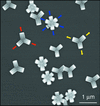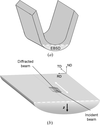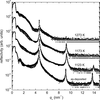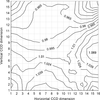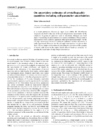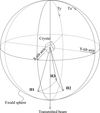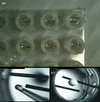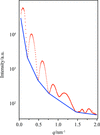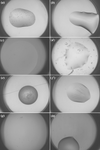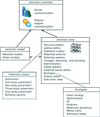issue contents
December 2010 issue

Cover illustration: PDB_REDO optimization of the oldest structure with experimental data in the PDB [155c; Timkovich & Dickerson (1976). J. Biol. Chem. 251, 4033-4046]. Front: final structure - warmer colours show greater atomic displacement. Back: final structure model with atomic trajectories in yellow. Courtesy of Joosten et al. [J. Appl. Cryst. (2009), 42, 376-384].
editorial
Free 

The problem of undercounting of citations that are published only in supplementary material is studied for the journals Nature, Science, Cell and the Proceedings of the National Academy of Sciences (USA).
research papers
Efficient algorithms for the simulation of an X-ray diffraction pattern using finite element data as input are developed and applied to concrete problems in semiconductor research.
Crystallographic and nanostructural analysis of GaN tripods and hexapods was performed using reciprocal-space mapping, transmission electron microscopy and atomistic modelling.
It is found that in LiTaO3 crystals with compositions between congruent and stoichiometric and in mixed LiNbxTa1−xO3 crystals self-organized stripes appear whose widths vary with temperature. They are broad and indistinct when the birefringence is close to zero and become narrower as the temperature is decreased or increased.
The origin of the electric field-induced strain in the polycrystalline ceramic 0.92Bi1/2Na1/2TiO3–0.06BaTiO3–0.02K1/2Na1/2NbO3 was investigated using in situ high-resolution X-ray and neutron diffraction techniques.
Two different approaches for a through-thickness texture profile assessment applying the energy-dispersive X-ray diffraction method are presented. The conducted measurements should give a first insight into the possibilities of fast and nondestructive texture gradient analyses by means of integrating diffraction methods.
A new fragment-based growth strategy (in-crystal chemical ligation) for lead compound generation is proposed, which is based on in situ chemical ligation and is operable in X-ray-based fragment screening format. Proof-of-concept experiments demonstrate that protein crystals charged with an anchor molecule not only function as a reaction field for chemical ligation but also serve as a platform on which to select self-assembled products.
Highly concentrated distributed crystallographic orientation measurements within individual crystalline grains are analysed by means of ordinary statistics neglecting their spatial reference.
Open  access
access
 access
accessA simulation of a CCD area detector is presented. The methods for error estimation on data obtained from images from such detectors by two-dimensional integration are considered and improvements incorporating a realistic instrumental response are suggested.
Certain interesting growth features of point defects, which commonly occur in single crystals but are difficult to observe directly, such as their origin, clustering and dynamics, have been demonstrated in a potassium dihydrogen phosphate crystal grown at an intentionally fast growth rate by the temperature-lowering method.
This paper reports the conditions that make possible the generalization of the Porod law to small-angle scattering intensities collected under grazing incidence.
A novel procedure is presented for the small-angle X-ray scattering analysis of the organization and size of mineral nanoparticles in pathological bone using a stack of cards model.
Novel twining relationships between three diopside dendrite crystals have been found by electron backscattered diffraction. The twin laws and the lattice coincidence have been analysed.
Combined in situ small- and wide-angle X-ray scattering was applied to investigate the dynamical properties of dry oleic acid-capped titanium dioxide nanorods during annealing in an inert gas stream, using a recently developed laboratory setup.
The average structure of Na0.5Bi0.5TiO3 was found to possess non-rhombohedral symmetry, as supported by the splitting of Bragg peaks in the high-resolution reciprocal space maps.
Download citation


Download citation


A new high-intensity laboratory diffractometer has been developed and optimized for single-crystal diffraction experiments under a range of sample environments.
Ultrasound is demonstrated to promote nucleation during protein crystallization by decreasing the energy barrier for crystal formation. Preliminary X-ray diffraction data also support the use of ultrasound to produce higher-quality protein crystals.
Open  access
access
 access
accessBased on the minimum shear criterion, a direct and simple method is proposed to calculate twinning elements from the experimentally determined twinning plane for Type I twins or the twinning direction for Type II twins. It is generic and applicable to any crystal structure.
A high-performance W/B4C multilayer mirror was measured by grazing-incidence small-angle X-ray scattering in order to analyse the lateral and vertical correlations of the interface roughness within the framework of a scaling concept of multilayer growth. Thermal stability and oxidation behaviour were also tested.
Effective methods have been developed for empirical data scaling performed after the inclusion of known anisotropic effects that influence the measured intensities of diffraction reflections.
The impact of unit-cell uncertainties on the uncertainties of derived structural quantities is discussed.
Open  access
access
 access
accessTwo multipurpose sample cells of quartz (SiO2) or sapphire (Al2O3) capillaries, developed for the study of solid–gas reactions in dosing or flow mode, are presented. They allow fast change of pressure up to 100 or 300 bar (1 bar = 100 000 Pa) and can also handle solid–liquid–gas studies.
A novel algorithm is introduced for fast and nondestructive reconstruction of grain maps from X-ray diffraction data.
The Beaucage model has been analyzed carefully. A note of caution is sounded about undesired artefacts produced by this model.
Recent instrumental developments specifically adapted for anomalous small-angle X-ray scattering from charged soft matter are presented.
This work describes the procedures used to determine the hexagonal cell parameters of β-quartz from an experimental 00.1 β-quartz neutron multiple diffraction Umweganregung pattern measured at 1003 K.
A method is presented for determining the axis and angle of rotation between two neighbouring grains using a goniometer mounted on a transmission electron microscope.
TiO2 thin films were grown by pulsed laser deposition on a wide variety of oxide single-crystal substrates. The effect of the nature and the orientation of the substrate on the phase stabilization and orientation of the films was studied by four-circle X-ray diffraction and the epitaxial relationships were determined.
short communications
A method for growing crystals on cryoloops or micromounts is described, and diffraction patterns of crystals of three proteins grown by both the new method and the conventional drop method are compared. The study investigates the steps for the automation of the crystal growth and manipulation process and describes the design of a tray for the method.
The diffraction properties of a crystalline silicon plate of which one face was mechanically indented have been studied. This treatment induced a permanent curvature in the sample, which allowed a diffraction efficiency of 88% for 150 keV photons, i.e. a reflectivity of 64% including the absorption.
computer programs
This paper describes a user-friendly multi-core accelerated program that fully analyses solution X-ray scattering data. The software is particularly useful for analysing supramolecular self-assemblies and for reconstructing the scattering signal in its entirety.
The computer program Jpowder, which allows the display and manipulation of powder diffraction data on any internet-capable device that includes a Java Runtime Environment, is described.
Hawk is the first publicly available open-source software package for reconstruction of coherent X-ray diffraction images. The large number of implemented algorithms and the ease with which it can be extended make it an ideal framework for the community to test and develop new algorithms.
ResDe is a suite of programs that allows the user to visually define and edit distance restraints for crystallographic refinement.
A suite of programs implementing a fast approach to the Debye function analysis of powder diffraction data from nanocrystalline and/or non-ordered materials is described.
This article describes a novel automated image analysis methodology affording unprecedented reliability and speed for identifying droplets in large-scale crystallization experiments.
A web-deployed interface has been developed for atomistic simulation with particular emphasis on crystalline materials.


 journal menu
journal menu










